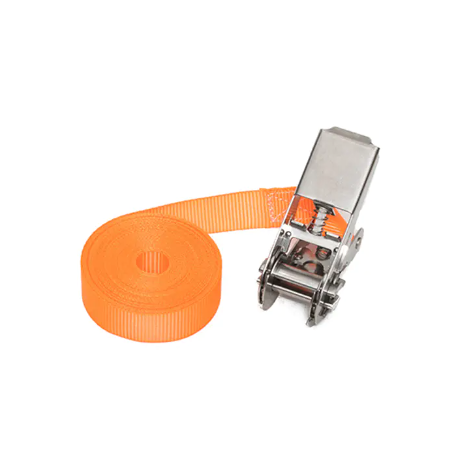Cat:1Inch Metal Ratchet Buckle
A 1-inch 25mm metal ratchet buckle is a type of buckle that is 1 inch in 25mm width and made of metal. It is commonly used for securing and tie down s...
See Details
Please follow these steps and suggestions. Incorrect cleaning methods can also damage the tie-down straps:
Preparation before cleaning
Identify the material: Most are made of polyester or nylon. Please check the label or instruction manual.
Remove the metal ends: If possible, remove the webbing from metal parts such as ratchet wrenches and wash the webbing separately.
Cleaning steps
Initial dust removal and beating:
First, use a vacuum cleaner to remove surface dust and loose particles.
In an open area, shake or gently pat the strap to dislodge any shallowly embedded sand or gravel.
Hand washing (recommended method):
Cleaning agents: Use neutral soap or detergent (such as dish soap). Never use strong acids, strong alkalis, bleach, or organic solvents (such as gasoline, alcohol, thinner), as these will severely damage the fibers.
Water Temperature: Use cold or warm water (below 40°C) to avoid hot water causing fiber shrinkage or deformation.
Instructions: Gently scrub both sides of the strap with a soft-bristled brush or sponge dipped in soapy water, focusing on areas with noticeable stains.
Thorough Rinse:Rinse thoroughly with plenty of water, ensuring all detergent is removed without residue.
Air Dry:A crucial step! Place the straps in a cool, well-ventilated, and dry place to air dry naturally.
Absolutely Do Not:
Place near heaters or fire sources to dry.
Expose to direct sunlight for extended periods (UV rays are a major cause of aging in synthetic fibers).
Use a washing machine for high-speed spin-drying.
Precautions: Machine Washing: Machine washing is generally not recommended, especially top-loading washing machines. Vigorous agitation and spin-drying can damage the fibers. If you must use a front-loading washing machine, select the gentle cycle and ensure all metal parts are removed.
Special Stains:
Oil Stains: Use a small amount of neutral degreasing detergent for targeted treatment.
Rust: Difficult to remove completely and may have already damaged the fibers; it is recommended to focus on checking the strength.
Storage: After washing and drying, it should be loosely rolled up and stored in a dry, dark place.

Safety Hazards (the most serious problem):
Increased Wear: Hard contaminants such as sand and metal shavings embedded in the strap will act like sandpaper, constantly abrading the fibers during tensioning and friction, greatly reducing the tensile strength of the webbing and potentially causing it to break suddenly under heavy pressure.
Corrosion Damage: If chemicals, salts, etc., remain on the strap, they will slowly corrode synthetic fibers (such as polyester and nylon), causing them to age, become brittle, and lose strength.
Inconvenience in Handling and Cargo Contamination:
Dirty Cargo: A strap full of oil and dirt will soil clean cargo (such as machinery, timber, food raw materials, etc.), causing economic losses.
Difficulty in Handling: A dirty strap may be difficult to pass smoothly through ratchet wrenches or other fastening devices, affecting binding efficiency. Gravel can also damage the wrench's gear mechanism.
Shortened lifespan: Regular cleaning effectively removes factors that accelerate aging, thus significantly extending the lifespan of the straps—a cost-effective practice.